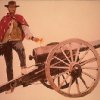Zoltán Harkácsi
 The last chapter from Sergio Leone’s so called Dollars trilogy is one of the most famous western movies among the two preceding chapters (A Fistful of Dollars, For a few Dollars More), as well as among other essential western movies. By giving a vivid and authentic description about the horrors of Civil War and at the same time depicting three of the most common features of contemporary humanity, The Good, The Bad and The Ugly is more than worthy to take its place among the legendary western movies.
The last chapter from Sergio Leone’s so called Dollars trilogy is one of the most famous western movies among the two preceding chapters (A Fistful of Dollars, For a few Dollars More), as well as among other essential western movies. By giving a vivid and authentic description about the horrors of Civil War and at the same time depicting three of the most common features of contemporary humanity, The Good, The Bad and The Ugly is more than worthy to take its place among the legendary western movies.
The story, which evolves around the three main characters, the good - Blondie (Clint Eastwood), the bad - Angel Eye (Lee Van Cleef) and the ugly - Tuco (Eli Wallach) is about the struggling and colliding fate of these three seemingly different, still in some respect interrelated individuals. Leone admitted, that some of the most stereotypical features they bear, such as greediness (Tuco), cruelty (Angel Eye) and nobleness (Blondie) were taken from his own personality and their fate (particularly Tuco’s) resemble to some events from his own life.
The basic concept of the story intends to demonstrate the persistence and enthusiasm of 19th century American men regardless of personality (three different characters insisting on chasing their aim of finding the treasure) and despite the presence of dire circumstances (Civil War - the war between North and South and its disastrous expense of human life). There are several themes the movie tries to emphasize including war, trust, treachery, death, life and the pursuit of wealth which sees through the entire plot. Another essential topic that develops throughout the story is friendship. In spite of the fact, that Tuco and Blondie seemed to establish a rather ambivalent relationship with one another, and they make several attempts to double cross and kill the other, their collaboration against Angel Eye in the ending section of the film as well as in some previous scenes provides evidence for the viewer that they in a curious way complement each other. Whether or not that can be regarded as friendship, their teamwork and distress for each other is clear.
The theme of war, unlike in the previous films of the trilogy, has a great significance in this movie. As an addition to the typical western characters – the bandit, the bounty hunter, and the lone hero – the appearance of soldiers puts these ordinary character classes into another role. Ironically enough, the problem of death was a frequent issue of the previous films, yet it was only taken into consideration in the battle scene between the Union and Confederate forces, when at the sight of genocide on both sides, Blondie gave utterance to his astonishment by saying: “I've never seen so many men wasted so badly”. Given his old profession as an ex bounty hunter, for him death is not supposed to be a matter of concern, still by witnessing the massacre at the battle of Branstone Bridge, he suddenly begins to reappraise the value of life. This might be an indication of the ruthlessness of war towering over the ruthlessness of homicide.
Another startling example for the devastation of war is the portrayal of the prison camp. Railed off and secured with sentries, the huge territory, where hundreds of Prisoners of War are held captive, is a representation of human cruelness and violence. Angel Eye, the antagonist in the movie is the Union sergeant in the camp, who deliberately tortures and exploits the captives and does so on the basis of his speculation about the opposing forces doing the same thing to the Union captives – an example of how even glorious individuals may turn to merciless monstrosities by the struggle and stress one is forced to suffer during war.
To sum up, there are quite a few themes in the movie aimed to equilibrate the world of the wild west and that of the Civil War. By emphasizing three complementary and at the same time opposing features – good, bad, ugly – as well as providing a comic, yet afflicted, fictional, yet realistic picture of one of the most controversial and troublesome era of American history, The Good, The Bad and The Ugly proved to be a worthy film adaptation of the last episode from Sergio Leone’s renowned trilogy.
(2009)
